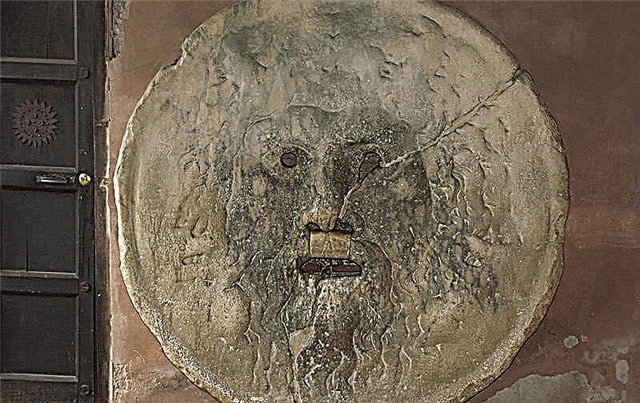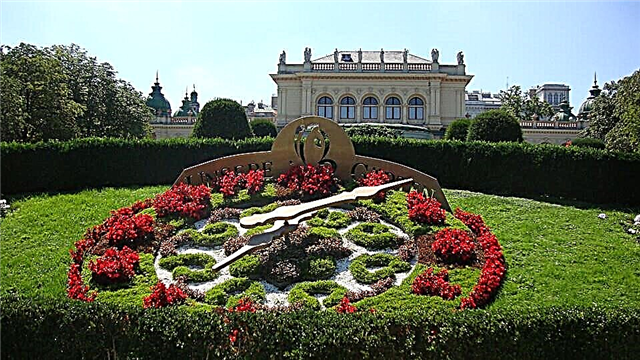Address: Russia, St. Petersburg, Nikolskaya square
Building: 1753 - 1762 years
Architect and author of the project: Savva Ivanovich Chevakinsky
Coordinates: 59 ° 55'20.7 "N 30 ° 18'00.1" E
Object of cultural heritage of the peoples of the Russian Federation
Content:
On Nikolskaya Square in the northern capital, there is an elegant cathedral - an architectural monument of the Elizabethan Baroque. The blue and white church was built by the Naval Department in the middle of the 18th century and has been perfectly preserved to this day. The unusual temple made its contribution to the toponymy of the city. A lane, a square, a market and two St. Petersburg bridges are named after him.

Nikolsky Naval Cathedral from a bird's eye view
Church history
One of the most beautiful cathedrals and churches in St. Petersburg is closely related to the history of the Russian Navy. Even under Peter I, a Morskaya Sloboda was formed between the Moika and the Fontanka, where those who worked to create a powerful Russian fleet settled. The one-story barracks were occupied by sailors who served on warships. In memory of this, the old names have been preserved - Kanonerskaya Street and Kanonersky Lane.
For the spiritual care of the sailors in 1714, a chapel was made "in the houses" of the regimental court, where priests from the Alexander Nevsky Lavra came. In 1733, a new linen church was arranged for the sailors in a large log hut.
10 years later, on the parade ground of the Marine Regimental Court, next to the future Kryukov Canal, a wooden church was erected and a small cemetery was laid out near it. Almost 3.5 thousand sailors were assigned to the big parish, not counting their parents, wives and children.

In 1752, Prince Mikhail Golitsyn asked the Russian Empress Elizaveta Petrovna to build a new stone church in the city and consecrate it in honor of the heavenly patron saint of sailors and wanderers - St. Nicholas. For the construction it was supposed to use the funds of the Naval Department, "bridge" money and private contributions.
The building project was entrusted to Savva Ivanovich Chevakinsky. The talented architect was a student of Francesco Bartolomeo Rastrelli himself and served as a staff architect in the Admiralty College. As a model, he used the beautiful cathedral in Astrakhan, which at one time Peter I really liked.
In the first half of the 18th century, one-domed churches with a spire, similar to the Peter and Paul Cathedral, were erected in St. Petersburg. The idea of Chevakinsky to build a five-domed cathedral caused surprise. The new St. Nicholas Church marked the return of Orthodox architecture to the traditions of pre-Petrine architecture.

In the original project of Chevakinsky, the cathedral was small. But severe floods on the Neva made adjustments. To prevent the floor from being flooded with river water, it was decided to raise the building above the ground and significantly increase its size. The foundation stone of the new church took place in the summer of 1753. The first stone in the foundation of the cathedral was laid by Archbishop Sylvester.
All church utensils for divine services were bought at the expense of the Admiralty Board. An elegant brass chandelier was brought from Nuremberg. The icons for the cathedral were painted by the famous iconographers Mina and Fedot Kolokolnikov, and the carved iconostasis was made by the skilled craftsman Ignatiy Kanaev. The metal structures for the heads were made in Tula at the P. A. Demidov plant, the bells were cast at the Mozzhukhin plant in Moscow.
The lower temple was consecrated in 1760, and the upper one in 1762. Empress Catherine II, who was present at the solemn event, commanded to call the temple "Naval Cathedral". This is how his special role in the life of Russian sailors was determined. Year after year, long-awaited military victories were celebrated here, thanksgiving and memorial services for the dead were served. In addition, Catherine II presented the cathedral with 10 icons in expensive gilded vestments.

Years passed, but the original appearance of the church remained almost unchanged. In the 19th century and the beginning of the last century, there was a women's almshouse, a school, a shelter and a charitable society at the temple. In 1901, stoves were built on the second floor of the cathedral, so the premises became warm.
The October Revolution and the events that followed it directly affected the position of the ancient cathedral. In 1918 the church received parish status. A few years later, all church valuables were removed from the building - silver and gilded vessels, vestments and crosses weighing 328 kg. The parishioners managed to redeem part of the temple relics, but in return they contributed an equal amount of silver to the treasury.
In 1933, in Leningrad, they decided to stop ringing bells. A year later, all 13 bells with a total weight of more than 20 tons were removed from the bell tower of St. Nicholas Cathedral and sent to be melted down. For many years the cathedral remained “voiceless”.

View of the cathedral bell tower
Under Soviet rule, the temple was not closed. During the war, parishioners collected many donations to the city's defense fund. The total amount of contributions exceeded 4.7 million rubles. To make the building less affected during enemy raids, it was masked with a net, and the domes and roof were painted in a protective color. Until 1999, the cathedral served as the city's cathedral church.
Architectural features
Nikolsky Naval Cathedral is one of the best baroque monuments in St. Petersburg. The place for it was chosen very well. The narrow Kryukov Canal connects all sea warehouses and garrisons. From the temple it is easy to swim to the mouth of the Neva, New Holland and the Admiralty shipyards.
The two-storey building is made in the form of an equal-pointed cross and topped with a gilded five-domed dome. The cathedral is decorated with columns that stand on three pedestals. The facades are richly decorated with stucco moldings, cornices and balconies decorated with openwork gratings.

Cathedral bell tower clock
Opposite the cathedral is a four-tiered bell tower with a spire. The high building was built in the middle of the 18th century by the same architect, S.I. Chevakinsky. On the upper tier there is a belfry and a round clock. The picturesque monument of architecture is very fond of drawing by St. Petersburg artists.
St. Nicholas Cathedral amazes with its splendor not only during the day, but also at night. Bright beams of floodlights effectively illuminate tall golden domes, slender white columns and intricate stucco decoration. This is one of the most romantic places in the northern capital, which is pleasant to admire from land and water during excursions along the city's canals.
Interior decoration
The interiors of St. Nicholas Cathedral are unique, since not a single temple with the original baroque decoration has survived in St. Petersburg. The spacious cathedral can accommodate 5,000 worshipers.

Interior decoration of the Nikolsky Naval Cathedral
Inside you can see memorial plaques with the names of the crews of sunken submarines. The pride of the cathedral is a beautiful carved iconostasis with icons, which are made in the tradition of Byzantine isographers. The lower church houses the icon of St. Nicholas, revered by believers, written in the 17th century by Greek craftsmen.
Memorial of Naval Glory
In 1908, a monument to Russian sailors who died in the Russian-Japanese war of 1905 appeared in the square of the cathedral. The project of the monument was carried out by the naval officer Prince Putyatin.
This monument marked the feat of 833 officers and sailors of the battleship "Emperor Alexander III", who fell in battle near the island of Tsushima. The inauguration of the memorial was attended by the relatives of the victims, Empress Maria Feodorovna and members of the royal family.

Monument to the heroes of the battleship "Emperor Alexander III"
In Soviet times, the historical monument was not cared for in any way. It was dilapidated, and decorations and memorial plaques were gone. In 1973, the granite stele was completely restored.
The tall monument stands on a pedestal of three stone steps. It is crowned with a bronze eagle and an Orthodox cross. On the stele you can see metal plaques with a dedication to the guards' crew, the war years 1904-1905, a bas-relief, the history of a warship, as well as a list of officers and lower ranks.
Useful information for visitors
The doors of the temple are open daily from 6:30 am to 9:00 pm. Four thrones have been consecrated in the cathedral - Epiphany, in honor of St. Nicholas, the Beheading of John the Baptist and saints Dmitry, Metropolitan of Rostov and Theodosius, Bishop of Chernigov.
Two Liturgies are held daily - at 7:00 and 10:00, as well as an evening service at 18:00. The cathedral has a lecture hall and a Sunday school for children and adults. There is a library of spiritual literature and a youth club.

Cathedral domes view
How to get there
The temple stands on Nikolskaya Square, in the place where the Griboyedov Canal intersects with the Kryukov Canal. It takes 12-15 minutes to get to it from the metro stations "Spasskaya", "Sadovaya" and "Tekhnologicheskiy institut-2". City trams, buses and minibuses stop near the cathedral.











